Emitting pulses in the picosecond and femtosecond regimes, ultrafast lasers are delivering more power, more flexibility, and smaller footprints to meet growing demand from the industrial sector.
FAROOQ AHMED, CONTRIBUTING EDITOR
With pulse lengths down to the picosecond realm and beyond, ultrashort-pulse lasers — often called ultrafast lasers — have been deployed as scientific research tools for decades. The fields of femtochemistry, spectroscopy, and multiphoton imaging, in particular, have benefited from the technology, which has since enabled new investigations in neuroscience and quantum mechanics.
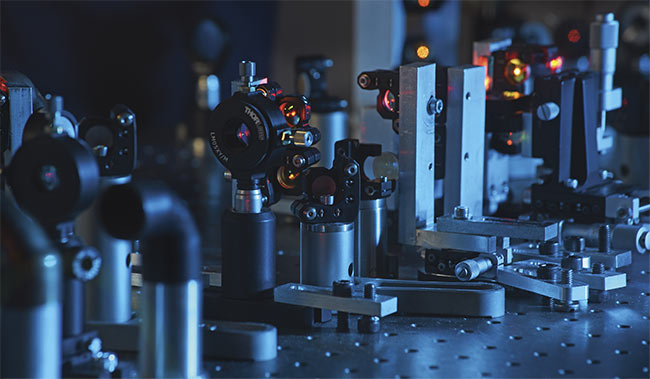
As highly complex optical instruments, ultrashort-pulse laser systems have historically been difficult to maintain and operate, requiring layers of electronics or cooling to achieve consistent pulse quality or spectral stability. Improvements to the underlying architectures, however, have made these systems more robust, reliable, and manufacturable at scale. Courtesy of Chromacity.
Now, however, ultrafast lasers are starting to expand beyond their traditional research niche. Picosecond instruments, which have been commercially available for more than 20 years, are only recently reaching a point where their overall cost of ownership has become attractive enough for use in industrial applications.
“Large-scale deployment of picosecond lasers started in the last five to seven years,” said Vincent Issier, director of product line management at California laser manufacturer Lumentum. “Before then, ultrafast lasers were a tool of last resort.”
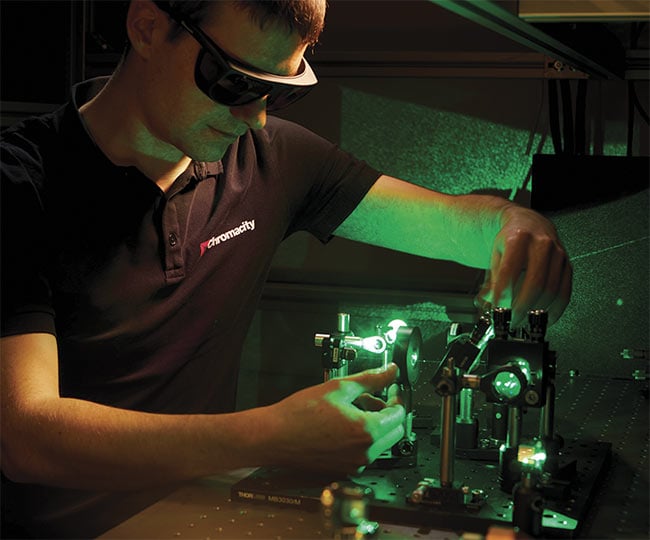
A confluence of factors — including technological evolution and a broadening user base — are contributing to the burgeoning market for ultrafast laser technology. The market is poised to increase at a 16.6% compound annual growth rate over the next five years — even when accounting for a slowdown related to COVID-19. Courtesy of Chromacity.
They are becoming mainstream, he
said, in part because they can now compete with micromachining solutions. “This is a new development in our industry,” Issier said. Lumentum’s PicoBlade 2 ultrafast laser was released in 2016 to target this market and has since undergone a redesign to make the technology available in a much smaller package to facilitate its integration into industrial systems.
Micromachining tools
Several factors are contributing to the momentum behind the industrial ultrafast laser market that, according to market research firm reports, is poised to increase at a 16.6% compound annual growth rate over the next five years — even when accounting for a slowdown related to COVID-19.
The first of these factors may simply be that a large-scale need has finally arisen. “What’s really driving the adoption is consumer electronics,” said Herman Chui, senior director of product marketing at MKS Instruments, which makes manufacturing equipment and owns laser manufacturer Spectra-Physics. But demand for industrial ultrafast lasers is also growing in the automotive, bioimaging, and medical sectors, where the tools are enabling new manufacturing capabilities or replacing other technologies, including longer-pulse-width laser processes.
Chui said that ever since 2007, when Apple released the first generation of the iPhone, entire categories of electronics — such as tablets, AR/VR devices, and wearable medical devices — have become commercially available. “And these devices are getting smaller and smaller, with more features packed into them,” he said. “You need to be able to machine materials like printed circuit boards and OLED displays with finer features — without imparting a lot of heat, which can damage the material. Ultrafast lasers are great for these applications.”
In the past, Lumentum’s Issier said, these processes were done mechanically, using drills to create lines and holes in the components that make up the electronics. “But there comes a point when reducing the size of the drill bit no longer becomes practical — coupled with replacement costs from wear and breakage,” he explained. These repairs, in turn, contribute to downtime, decreasing a machine’s usability and increasing its cost of ownership.
Because industries are always looking for ways to minimize production-related expenses, the processing quality of ultrafast lasers plays a big part in their value. “With the right performance — wavelength, energy, pulse duration, and delivery optics — you can minimize the heat-affected zone in materials [and] minimize debris creation, recast, discoloration, and so on. This is a huge advantage,” Issier said.
Reliable lasers
Of course, work had to be done on the laser side to ensure that ultrafast instruments could compete on a day-to-day basis with long-established, always-on mechanical micromanufacturing processes. As Lumentum’s redesigned PicoBlade illustrates, one competitive strategy is to diminish the size of ultrafast lasers to better integrate them into various manufacturing platforms and motion systems. But, enhanced reliability is also a major reason the ultrafast laser is now a more viable industrial solution, said Christopher Leburn, the commercial director and co-founder of Chromacity, a Scotland-based manufacturer and supplier.
“Historically, ultrashort-pulse laser systems have been inherently difficult to maintain reliably because these are highly complex optical instruments,” Leburn said. “They have required additional layers of electronics or cooling in order to reach a level of consistency in terms of pulse quality or spectral stability.”
He said that, over time, improved laser architectures have made them more robust and reliable and the process of manufacturing them more efficient. “We can then place those efficiencies across the customer in terms of price point,” Leburn said.
MKS Instruments’ Chui agreed. “It has taken time to come up with new ways to make these lasers adaptable for commercial use.” Many of these advancements were evolutionary changes over time, not step-function improvements. “They are refinements of existing laser architecture,” he said.
Inside the box
Most industrial ultrafast lasers are based on the long-established master
oscillator power amplifier (MOPA) design, in which the instrument consists of an oscillator that acts as a seed laser connected to an amplifier that increases the energy of the emitted pulse. This design allows for scalability in the laser manufacturing process by relying on a standardized platform. The oscillator is often fiber-based, while the amplifier can be based on fiber or solid-state crystals, depending on the final power output requirements.
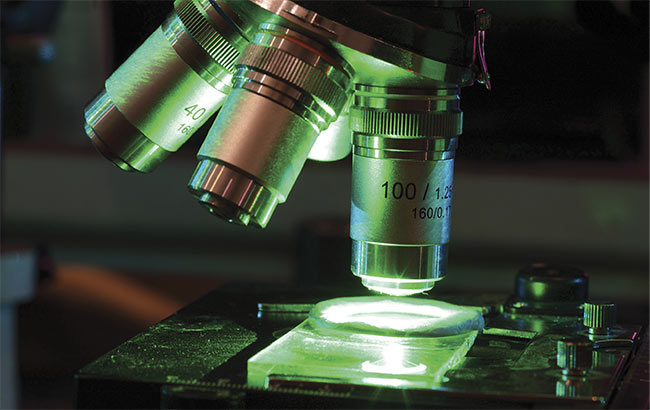
Long a tool in the research lab, ultrafast lasers have evolved to a point where their overall cost of ownership has become attractive enough to invite interest in their potential for industrial applications. Courtesy of Chromacity.
In general, fiber amplifiers are a more suitable choice when designing for output powers below 100 W, while solid-state amplifiers produce systems capable of higher output powers. Fiber can also suffer from nonlinear effects such as stimulated Brillouin scattering, stimulated Raman scattering, and the optical Kerr effect, all of which interfere with power output. These unintended effects are among the reasons why instrument manufactures often use a combination of materials in ultrafast and other laser systems.
Chui said MKS/Spectra-Physics uses such a hybrid architecture in its IceFyre picosecond lasers, which employ a fiber-based oscillator and a solid-state amplifier. “It’s an architecture we’ve been able to take from the nanosecond into the
picosecond and also femtosecond regimes.” He added that the decreasing costs and increasing capabilities of optoelectronic components, such as diodes, have played a role in boosting the cost-effectiveness of ultrafast lasers.
Chromacity’s Leburn spun the eight-year-old company out of laser research conducted at Scotland’s Heriot-Watt University. One of the company’s newer laser designs, an optical parametric oscillator (OPO) system, uses a gallium phosphide nonlinear crystal to generate picosecond pulses across the mid-infrared region. The oscillator is optically pumped by a high-average-power, 1-µm wavelength source based on a part fiber, part free-space laser. The components rest on a monolithic base plate, which contributes to the laser system’s compactness and reliability. A heat-efficient lasing system removes the need for water cooling, Leburn said.
Faster pulses
As ultrafast lasers have gained traction in industrial machining, they have been used to process an increasing variety of materials, including metals, glass, gemstones, and plastics. The unique properties of these materials, as well as their differing tolerances to laser light pulses, have
pushed manufacturers to develop instruments with the capabilities necessary to process them.
‘With the right performance — wavelength, energy,
pulse duration, and delivery optics — you can minimize the heat-affected zone in materials [and] minimize
debris creation, recast, discoloration, and so on.
This is a huge advantage.’
— Vincent Issier, director of product line management at Lumentum
Chui said that source developers are always working to find a balance between designing for customer requirements and anticipating where the market will go. “There are certain intersection points, and we have to look at our technology and see how we can intersect at the right point.”
MKS/Spectra Physics’ newer ultrafast lasers emit picosecond pulses in the UV and green wavelength regions of the spectrum through harmonic generation. Several product lines also emit femtosecond pulses. Materials tend to absorb light better in shorter pulses, which produce shallower absorption depths. Femtosecond lasers also have a lower thermal impact on material than picosecond lasers do, resulting in a smaller heat-affected zone. However, their throughput can be slower and their cost higher when outputting the same power. So, the parameters of the pulse — wavelength, shape, and train type — can make a big difference.
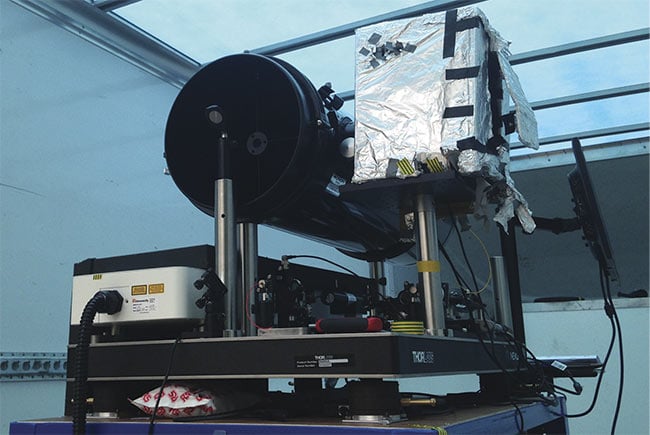
Researchers at Heriot-Watt University recently demonstrated that ultrafast laser technology could enable real-time measurement of a simulated gas leak at a range of over 200 m. Their experimental setup employed a telescope, a scanning Michelson interferometer, a detector, and a Chromacity optical parametric oscillator (OPO) using a gallium phosphide nonlinear crystal to generate picosecond pulses across the MIR region. The entire kit fit onto a 60- × 90-cm breadboard that could fit in the back of a truck. Courtesy of Heriot-Watt University.
“It’s about optimizing the interaction of the light with the material,” Chui said. “Ultrathin glass-cutting benefits from ultrashort pulses because you can get edge surface roughness down to the tens of nanometers without any post-processing.” In flat panel display manufacturing, for example, this advancement can contribute to bringing down manufacturing costs, he said.
Femtosecond pulses can also broaden the uses for ultrafast laser systems, Chromacity’s Leburn said. The company’s femtosecond lasers have been deployed
in semiconductor wafer inspection applications, which require high pulse repetition rates and low pulse energies. They also offer sources that can deliver light across a variety of wavelengths, from 5 to 12 µm, a spectrum that offers benefits to the environmental, defense, and security sectors. “Gases, liquids, and solids have very well-defined chemical signatures in the mid-infrared region, so these lasers are useful in chemical analysis,” he said.
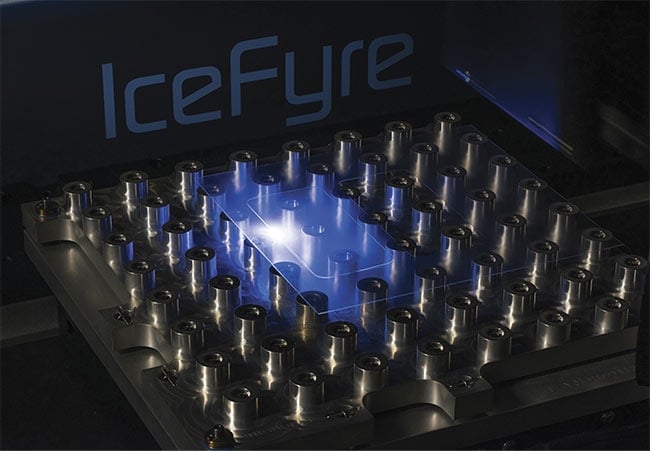
A high-power picosecond pulsed laser cuts OLED display film. The ultrashort pulses of picosecond lasers are very effective in machining finer features on printed circuit boards and OLED displays without imparting a lot of heat, which can damage the part. Courtesy of MKS Instruments.
Plastics and polymeric materials benefit from lasers that emit UV light, which generates less heat than infrared pulses. Lumentum’s PicoBlade 3, which was released last year, is available in UV and green wavelengths, in addition to infrared bands. It operates at 4× the power of previous iterations.
“Customers wanted more power because it gives them higher throughput for parallel processing of materials,” Issier said. He believes that the next few years will see an increase in industrial ultrafast laser deployment. “I think additional uses will appear, like surface texturing — sculpting hydrophobic or hydrophilic properties right onto the materials through laser processing,” Issier said.
Chromacity’s Leburn sees the lasers getting increasingly smaller — so much so that they eventually become portable. “We’ve taken measurements of methane, ethane, and water vapor out in the field with one of our ultrashort-pulse OPO systems, detecting chemical signatures at distances up to 70 m with parts-per-billion resolutions. This would not have been possible with legacy technologies,” he said.
There are only two challenges to creating more compact ultrafast laser systems, Leburn said. “Time and resources — not physics.”
www.linkedin.com/in/farooqtheahmed
Acknowledgments
The author would like to thank Vincent Issier of Lumentum, Herman Chui of MKS Instruments, and Christopher Leburn of Chromacity.